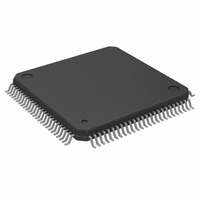SLXT914QC.B3 Intel, SLXT914QC.B3 Datasheet - Page 12

SLXT914QC.B3
Manufacturer Part Number
SLXT914QC.B3
Description
IC QUAD ETHERNET REPEATER 100QFP
Manufacturer
Intel
Type
Repeaterr
Datasheet
1.NLXT914PC.B3.pdf
(45 pages)
Specifications of SLXT914QC.B3
Rohs Status
RoHS non-compliant
Tx/rx Type
Ethernet
Voltage - Supply
4.75 V ~ 5.25 V
Current - Supply
180mA
Mounting Type
Surface Mount
Package / Case
100-QFP
Delay Time
-
Capacitance - Input
-
Other names
831521
Available stocks
Company
Part Number
Manufacturer
Quantity
Price
Intel
Table 6.
Table 7.
31-Oct-2005
12
®
LXT914 Flexible Quad Ethernet Repeater
Miscellaneous Control Signal Descriptions
LED Driver Signal Descriptions
PLCC
PLCC
19
20
21
22
23
24
25
27
28
29
30
31
32
33
PQFP
PQFP
18
19
21
22
23
24
25
32
33
34
35
36
37
38
(External)
(External)
(External)
SECTP1
SECTP2
SECTP3
SECTP4
Symbol
SECAUI
Symbol
LEDTP1
LEDTP2
LEDTP3
LEDTP4
LEDAUI
RESET
LEDCF
LEDJM
(Local)
(Local)
DSQE
TEST
FPS
Intel
®
Order Number: 248989, Revision: 003
LXT914 Flexible Quad Ethernet Repeater
I/O
I/O
O
O
O
O
O
O
O
I
I
I
I
I
I
I
I
I
Test Mode Select. This pin must be tied Low for normal operation.
RESET. This pin resets the LXT914 circuitry when pulled High for ≥ 1 ms.
DSQE. In Local Mode, this pin controls the SQE function. When High, the
SQE function of the AUI port is disabled. When Low, SQE is enabled.
Security Mode Select (TP Port 1). In External Mode, this pin enables the
security mode for twisted-pair port 1. When pulled High, the LXT914 Jams
the port. This pin must be tied Low if external security control is not
required.
Security Mode Select (TP Ports 2–4). In External Mode, these pins
enable the security mode for the respective twisted-pair ports (TP1 through
TP4). When pulled High, the LXT914 jams the affected port. The SEC pins
must be tied Low if external security control is not required.
First Position Select. In the Local mode this pin identifies the first device
in a daisy chain configuration. When tied High (First position), the LXT914
controls the local EEPROM by providing clock and handshaking. When tied
Low (Not First), the LXT914 will accept CLK and data in its turn from
previous LXT914s in the data chain.
Security Mode Select (AUI Port). In the External mode this pin enables
the security mode for the AUI port. When pulled High, the LXT914 jams the
AUI port. The security feature is available only in External management
mode.
Collision & FIFO Error LED Driver. This tri-state LED driver pin reports
collisions and FIFO errors. It pulses Low to report collisions, and pulses
High to report FIFO errors. When this pin is connected to the anode of one
LED and to the cathode of a second LED, the LXT914 will simultaneously
monitor and report both conditions independently.
Jabber/MJLP & Manchester Code Violation LED Driver. This tri-state
LED driver pin reports jabber and code violations. It pulses Low to report
MAU Jabber Lockup Protection (MJLP), and pulses High to report
Manchester code violations. When this pin is connected to the anode of
one LED and to the cathode of a second LED, the LXT914 will
simultaneously monitor and report both conditions independently.
Twisted-Pair Port LED Drivers. These tri-state LED drivers use an
alternating pulsed output to report TP port status. Each pin should be tied to
a pair of LEDs (to the anode of one LED and the cathode of a second LED).
When connected this way, each pin reports five separate conditions
(receive, transmit, link integrity, reverse polarity and auto partition).
AUI Port LED Driver. This tri-state LED driver uses an alternating pulsed
output to report AUI port status. This pin should be tied to a pair of LEDs (to
the anode of one LED and the cathode of a second LED). When connected
this way, this pin reports five separate conditions (receive, transmit, receive
jabber, receive collision and auto partition.
Description
Description
Datasheet












